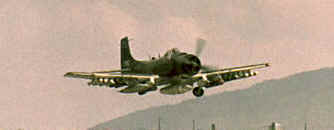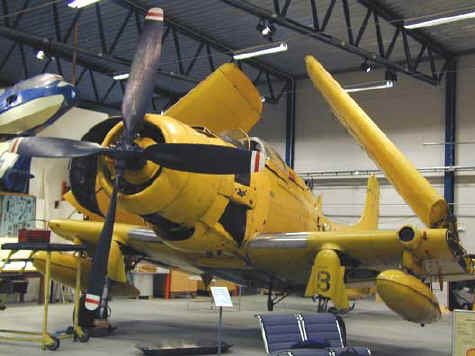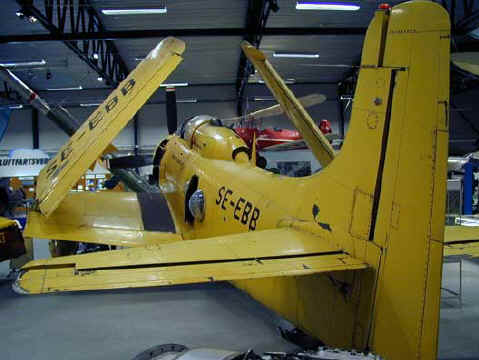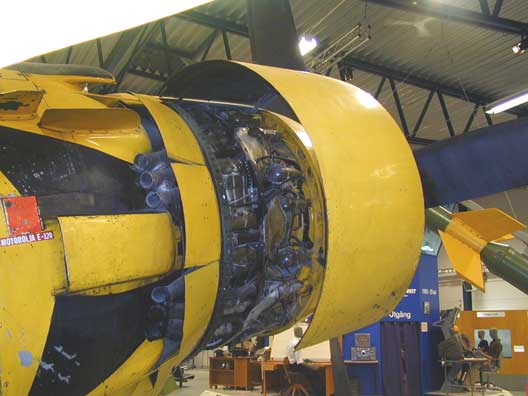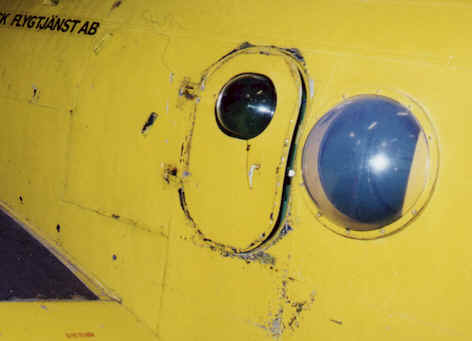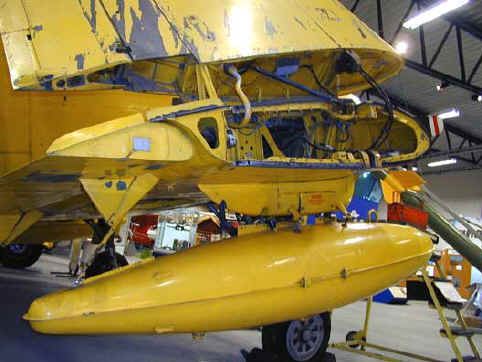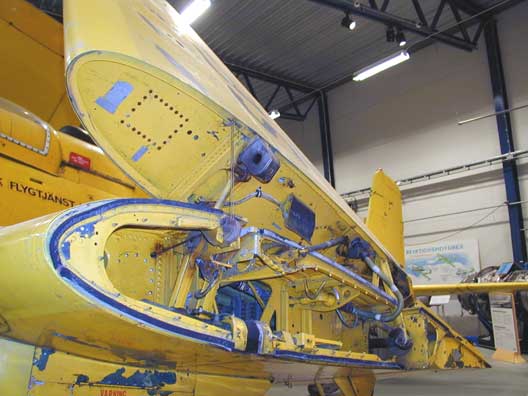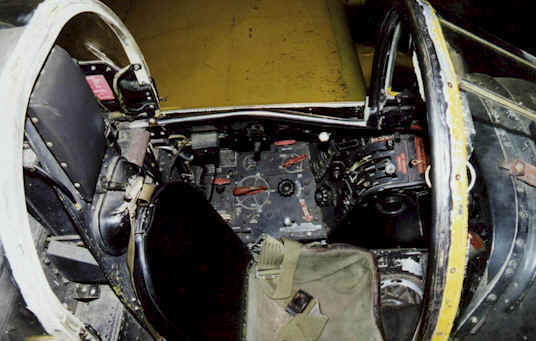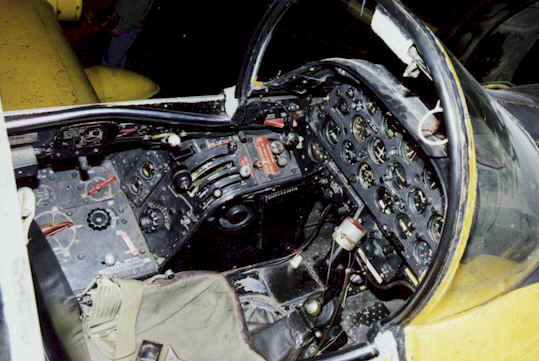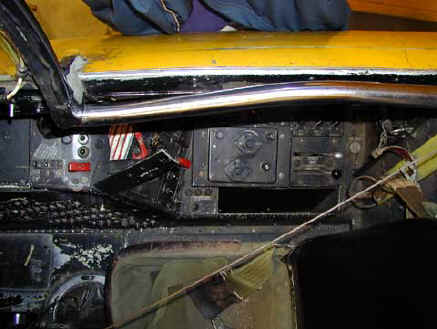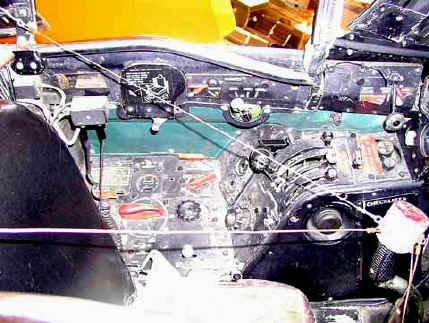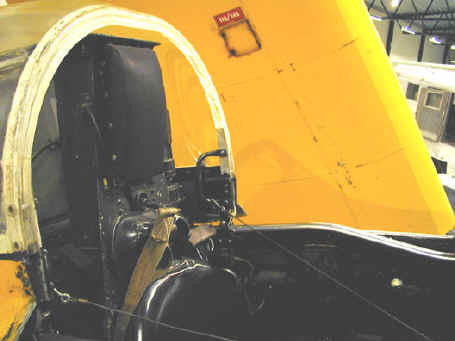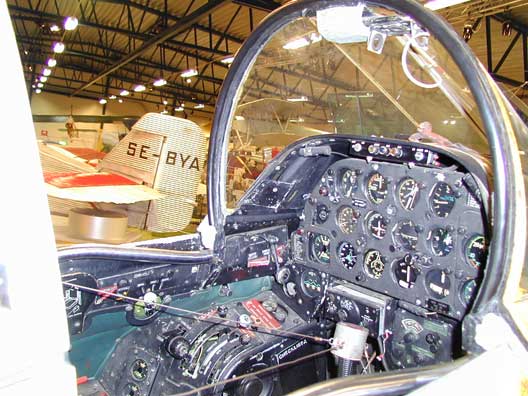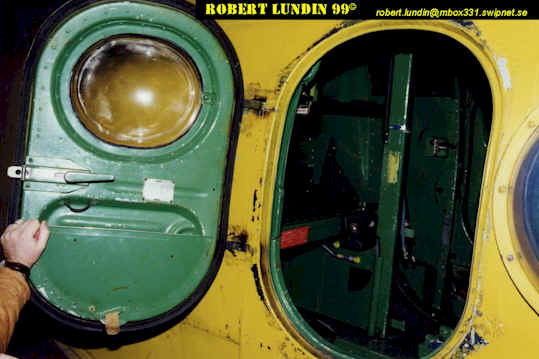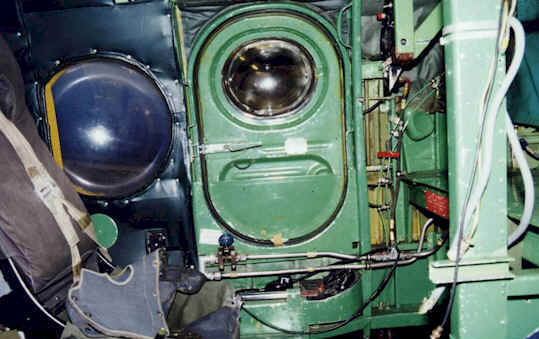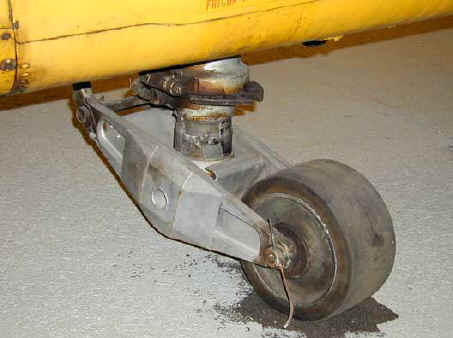By Dan Kut
additional photos by Robert Lundin
A couple of years ago someone on this site’s discussion forum asked for cockpit pictures of the Swedish Skyraider target tug. That somehow dwelled in the corner of my mind, waiting for the perfect moment to strike… Then when a friend of mine ask me what we should do to test his new digital camera I instinctively said ”Let’s go and take some shots of the Swedish Skyraider”. Being mostly interested in jets, the Skyraider is one of the few propeller machines that have caught my interest.
Skyraider is Born
The Skyraider was born in 1944, when Douglas Aircraft Company’s XSB2D Destroyer program for the Navy was cancelled. In conformity with the changing pattern of the war in the Pacific, the US Navy was then seeking a different attack aircraft and proposals from other manufacturers had already been requested.
Even though not officially invited to tender for the new program Ed Heinemann, Chief Engineer of Douglas’ EI Segundo Division, sat down in a Washington DC hotel room with his Chief Aerodynamicist Gene Root, and Chief Designer Leo Devlin determined not to be left out of the action. Working overnight, Heinemann and his team managed to produce preliminary drawings that when presented the following day, were so full of promise that Douglas were allowed to participate in the contest. However, the original deadline had to be kept, allowing Douglas for no extension to make up for the head-start of their competitors.
The prototype took to the air on March 18, 1945, two weeks ahead of schedule, and immediately proved that it was a though aircraft. The US Navy gave Douglas a letter of intent 543 BT2D-1’s ”Dauntless 11” which was later cut down to 277 after VJ (Victory in Japan) Day. Douglas continued with the pre-production series and testing. Some of these were also built/modified as Night Attack, Photo reconnaissance, Electronic Countermeasures, and Early Warning – AEW to prove the versatility of the new airframe. With hardly any relationship to the original Dauntless, the name was eventually changed in 1946 to AD-1 ”Skyraider”. The transition of the Skyraider versions from AD-1 to AD-7 spanned nearly ten years, and each major sub-type had further sub-versions.
In Action
The Skyraider was first to see action in the Korean war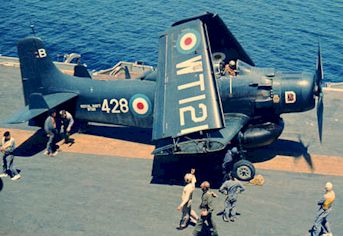 where it was used with large success by the US Navy and Marines. It was even regarded as the most successful aircraft of the 3-year conflict for the precision with which it could deliver its ordnance, it carved a unique niche for operational capabilities which could not be performed by any other aircraft (Hence ”Abel-Dog”). This success did not go unnoticed, and the first exports went to the Royal Navy in the form of 36 AD-4Ws which in British service were redesignated ”AEW 1”. Some of these ”pregnant” Skyraiders were to see action during the Suez Crisis. At the end of their career with the Royal Navy in 1962 they were acquired by Svensk Flygtjänst (Swedish Air Services Ltd) which provided target-towing duties to the Swedish Air Force. In late 1959 France received 113 AD-4s from ex-US Navy stocks to for operations in Algeria. The French also used them in 1964 in Cambodia and in 1975 in Chad. US Air Force, Navy and Marines used the Skyraider extensively in Vietnam. Many pilots preferred it over more modern fast jets for its ability to take great punishment and get the pilot back safely to base. And finally the (South) Vietnamese Air Force also acquired Skyraiders from USAF.
where it was used with large success by the US Navy and Marines. It was even regarded as the most successful aircraft of the 3-year conflict for the precision with which it could deliver its ordnance, it carved a unique niche for operational capabilities which could not be performed by any other aircraft (Hence ”Abel-Dog”). This success did not go unnoticed, and the first exports went to the Royal Navy in the form of 36 AD-4Ws which in British service were redesignated ”AEW 1”. Some of these ”pregnant” Skyraiders were to see action during the Suez Crisis. At the end of their career with the Royal Navy in 1962 they were acquired by Svensk Flygtjänst (Swedish Air Services Ltd) which provided target-towing duties to the Swedish Air Force. In late 1959 France received 113 AD-4s from ex-US Navy stocks to for operations in Algeria. The French also used them in 1964 in Cambodia and in 1975 in Chad. US Air Force, Navy and Marines used the Skyraider extensively in Vietnam. Many pilots preferred it over more modern fast jets for its ability to take great punishment and get the pilot back safely to base. And finally the (South) Vietnamese Air Force also acquired Skyraiders from USAF.
Arlanda Aeroexpo
Anyway my friend and I visited the Arlanda Aeroexpo, a small aircraft museum which is situated next to the SAS Academy near Arlanda airport in Stockholm. They display a number of civil aircraft where the yellow painted (For high visibility) Skyraider is the main attraction. SE-EBB started its life in 1952 with the construction number 7962. It was to serve with the Royal Navy as an radar carrying Airborne Early Warning (AEW) aircraft until 1962 when Svensk Flygtjänst acquired it. Removal of the belly radar and auxiliary tail stabilizers and installation of target towing equipment was undertaken by Scottish Aviation Ltd. It was used as a target-tug until 1974. Until the time Arlanda Aeroexpo opened its doors I believe It spent its life in a barn in Gotland.
Some Data
The 2700 hp, Wright Cyclone R-3350-26WA engine makes it the most powerful single-engined propeller aircraft in the world. The propeller has a diameter of 4.11m. The wings span 15.25m unfolded and 7.4m folded, length is 11.95 m, height 4.8m and 6 m with folded wings. Weight was around 10tons with 2685 liters of fuel. Take off distance was 400m and landing 800m. Cruising speed is 475 km/h.
For more information on the different versions and scale drawings on the Swedish Skyraider (AD-4W in US and AEW.1 in British service) I would recommend Scale Aviation Modeller International Volume 4 Issue No10 October 1998, which much of this text is based on. I would also recommend you to visit www.abledogs.com or www.skyraider.org
Douglas AD-4W Skyraider in Detail
As usual with large pictorial material, we divide it into sections presented below..
The airframe
Svensk Flygtjänst operated a total of 13 Skyraiders as turget tugs between 1962 till 1976. The aircraft carried civilian registrations of SE-EBA to -EBM. In the late sixties, the fourteenth aircraft was assembled from spare parts, as a replacement for a crashed specimen, and designated SE-EBN.
SE-EBB shown here was initially delivered to the Fleet Air Arm in 1952 and served with radar surveillance until 1962. In this year the aircraft had been converted to a target tug configuration and delivered to Sweden on October 23, 1962.
Overview from 7 a’clock. Apart from the radar belly, the other external differences between a normal Skyraider and the AD-4W/AEW.1 is the dorsal spine and the replacement of the airbrake with door for the radar operator. Also notice the omittance of auxiliary tail stabilisers.
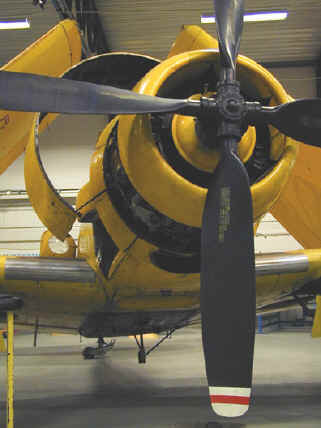 Front of the engine and propeller are clearly visible here. The towing hook has replaced the ”pregnant” radar belly of the original configuration.
Front of the engine and propeller are clearly visible here. The towing hook has replaced the ”pregnant” radar belly of the original configuration.
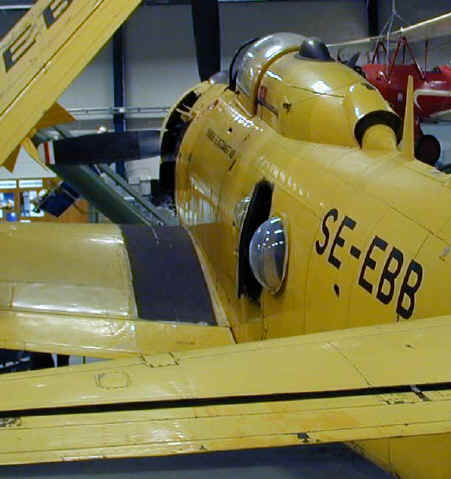 Port side details. One of the modifications as a target tug was the addition of a second, larger bubble-shaped window just aft of the door – on both sides of the fuselage.
Port side details. One of the modifications as a target tug was the addition of a second, larger bubble-shaped window just aft of the door – on both sides of the fuselage.
Note the matt black wing walkway. Also visible is the detail of the fuselage spine.
The Wright Cyclone R-3350-26WA engine exposed. The strange blueish tinge comes from the camera’s flash. The original color was black as on the other pictures.
Tug operator’s entry door. Photo: Robert Lundin
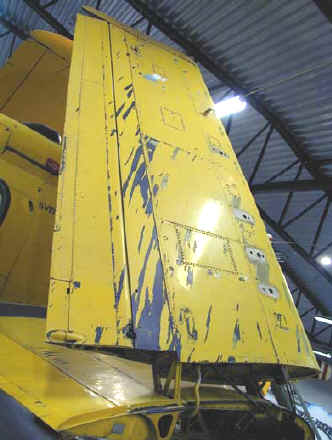 Starboard outer wing in the folded position.
Starboard outer wing in the folded position.
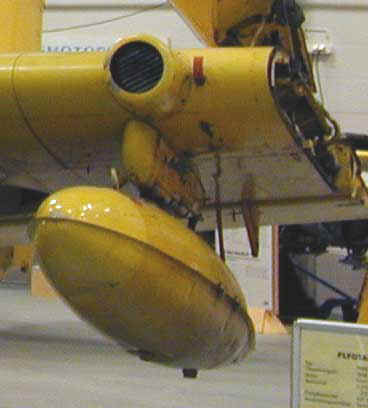 Port wing leading edge features this cylindrical shape. If I recall correctly it is a light with a grill in front of it.
Port wing leading edge features this cylindrical shape. If I recall correctly it is a light with a grill in front of it.
Overview of the wing folding mechanism, landing flap profile and drop tank mount.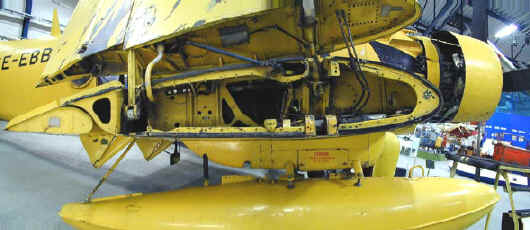
Two close-ups on the folding mechanism.
Interior detail
Overall view of the ”pilot’s office”. Photo: Robert Lundin
Well, what can I say – definitely a ”high-workload” cockpit! Photo: Robert Lundin
Starboard sidewall detail
…and the port side with prominent engine controls. The visible wire stretched across the picture secures the control column.
Pilot’s headrest. A detail worth noting is that there is no metal framing on the canopy rim.
The instrument panel
Operator’s entry door in the open position. Photo: Robert Lundin
Interior of the tug operator’s cabin. Photo: Robert Lundin
Landing gear
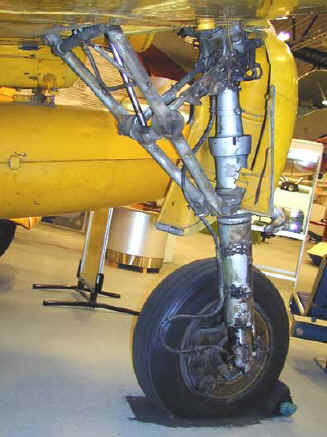 Port undercarriage leg viewed from the inboard side.
Port undercarriage leg viewed from the inboard side.
The AD4W / AEW.1 only had one gear cover shown here while other Skyraiders had two more covering the wheel itself when retracted.
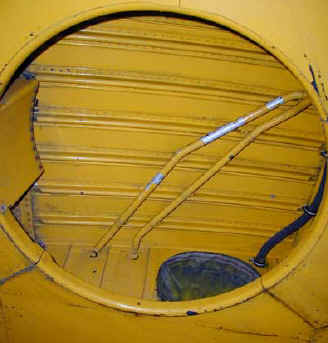 Port wheel well viewed directly from below. Forward is to the right on the picture.
Port wheel well viewed directly from below. Forward is to the right on the picture.
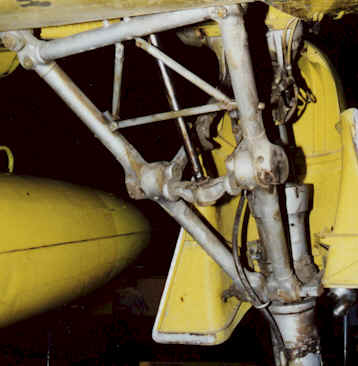 Details of the main gear’s retraction mechanism
Details of the main gear’s retraction mechanism
Photo: Robert Lundin
This article was originally published in IPMS Stockholm Magazine in December 2000.
